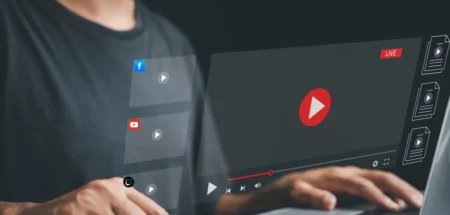Do you love playing games while sharing your experiences with online audiences? If so, you might have what it takes to be a great streamer like PewDiePie. But what is a streamer?
In simple terms, a streamer is someone who uses platforms like YouTube to live stream; from playing music or games, to cooking delicious food, and many more great things.
As a streamer, not only can you make new friends or fans, but you may also earn a lot of money by doing so.
If that makes you even more curious about what it’s like to be a streamer, this article is for you! Here, we’ll be about to answer questions: what are streamers, what does a streamer do, and many more. Read on.
Contents :
ToggleWhat is a Streamer?
A streamer is anyone who performs live broadcasts using online platforms like Twitch, YouTube, or Facebook to share ideas and experiences with their online audiences. In simple terms, streamers are those who do live-streaming.

Don’t get confused with the word streaming you heard before, which often relates to services like Netflix, Amazon Prime, or Spotify. That term refers to the use of services that allow people to stream data from their servers to enjoy available content.
That’s not the streamer’s definition that we would like to talk about in this article. Being a streamer means you’ll dedicate your time to producing your original content in front of your own viewers.
The technology of streaming today and high-speed internet access allows you to be live at any time online. So, you can interact with your viewers or subscribers using a certain platform like YouTube hassle-free.
That being said, if you want to be a streamer as a content creator, you no longer need to record your content offline, and then upload it.
Now, if that’s the case, what are streamers creating as content?
Well, it can be anything; from gaming to lifestyle and physical exercises like yoga. The possibility is endless. In fact, you’ll find many streamers focus on their niches and gain huge success due to their respective skills.
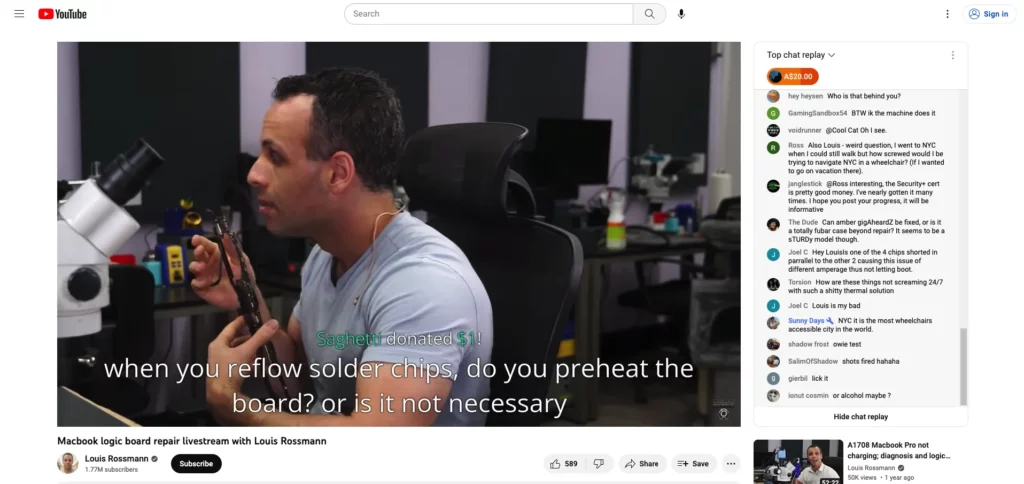
Take a look at how Richard Tyler Blevins, aka Ninja, boasts his skill in playing Fortnite while interacting with his 18.5 million subscribers. Also, you can see how engaging Louis Rossmann share his expertise on fixing a MacBook on his YouTube channel live.
In fact, the opportunity to be a streamer is still wide open.
What you need to do is pick up your niche and start a live-stream channel. While gaming streamer is still the most popular, it’s fine if you want to come out with a unique niche. As long as you have a special skill to share with the world, you’re good to go.
What Does a Streamer Do?
A streamer will stream online in front of their audiences using a specific platform. That’s what they do in general. But, what is a streamer doing that makes them a great content creator?
1. Schedule the Live Stream
You can stream at any time you like on any platform. But, most great streamers don’t do this as they want to make their audiences are there waiting for their live stream.
So, that’s why it is important to always schedule your next live-stream and inform your subscribers. This way, a streamer will get more loyal viewers quickly, which will help their popularity.
Not only that, scheduling will help you to plan your next content properly. This will hinder you from making poor content because of being unprepared. For example, you need to make sure that you place your camera at the perfect angle to produce awesome visuals.
If you use Twitch as your streaming platform, you must understand that the best time to live stream is around 11 AM – 2 PM Pacific Time. Also, a survey conducted by StreamScheme found that most streamers who are eager to grow their channel stream between four days per week.
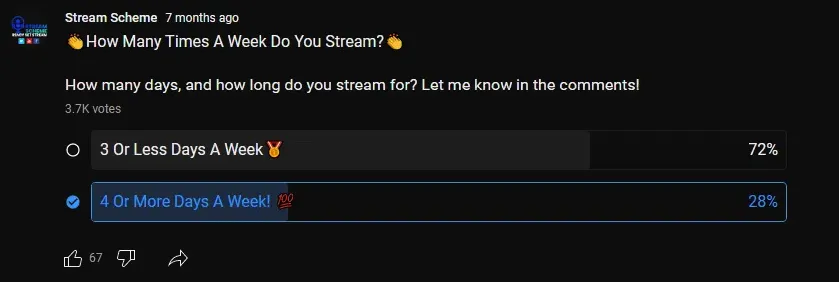
2. Create Awesome Content
Content creation is the heart of what streamers do. If they can produce unique content, it will help them to have more subscribers who are loyal to their channel.
Because audio and video are the products of your live stream, you need to make sure that the output is of high quality. Otherwise, it will make your content less enjoyable and make your viewers go.
Read More: Good Bitrate for Streaming
While it doesn’t mean that creating content will take most of the content creator’s time, some streamers like Andrew Bodine tried to push it to the limit. What is a streamer like Andrew doing?
In 2019, he streamed continuously for 573 hours on Twitch and slept only four hours a night. That means, he spent around 20 hours on camera to create a content that boost followers to his channel and set new records for marathon streaming.
Of course, you don’t have to do something similar as a streamer. As long as you can find your unique talent and share it with the world, then you can become the next best streamer.
3. Engage with the Audience
Bear in mind that creating content only is not enough to make you a streamer with millions of followers. You need to engage well with your audience during the live stream. This way, you can make the streaming experience more engaging for your subscribers.
The easiest way to do that is by reading comments on your live chat if you are able to do so. Or, you can mention some of your viewers’ names and comment on their comments. This will make your live stream more lively and fun.
Almost all great streamers like PewDiePie or Ninja always take time to read their audiences‘ comments. This will hinder their live streaming from becoming boring.
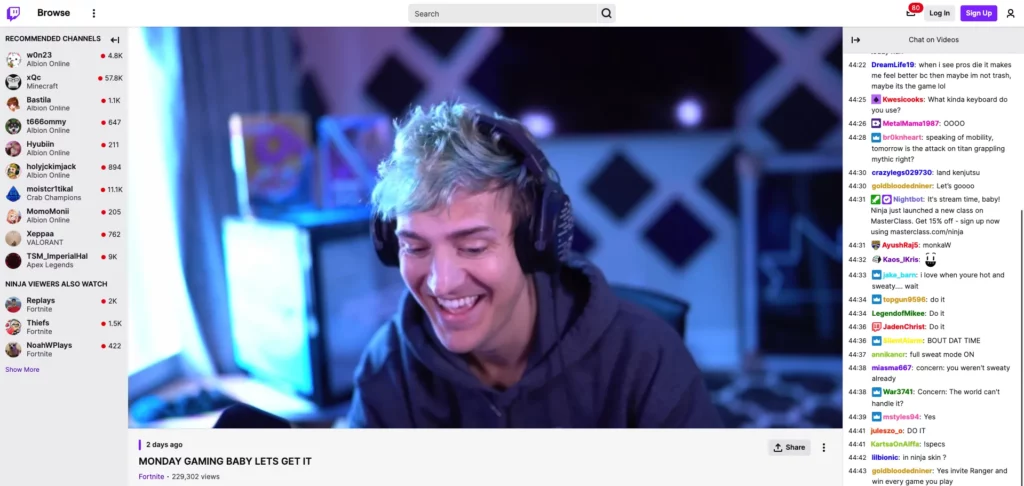
4. Collaborate with Other Content Creators
What else does a streamer do? The answer is collaborating with other content creators, or even celebrities to provide fresh, unique content in their channels. This is not a regular thing to do for most streamers, though. But if you can do so, it would be very recommended.
One of the most popular collaborated content is when Ninja and Drake play Fortnite Battle Royale in 2018. It is reported that the stream went viral and hat a fewer of over 630,000 as a record at a time.
Read More: Lessons From The Best Streamers
5. Monetize the Content
Unless you don’t want to be a professional streamer, one thing you will most certainly do is monetize your content or your personal brand. By doing so, you can make a living from streaming.
Don’t take it for granted. According to Statista, the revenue from live-streaming games alone is said to reach US$11.69 billion in 2023. What a huge number!
It doesn’t matter if reaching a certain income is challenging as a casual streamer. The truth is you can still monetize your content by accepting donations. Let’s say you want to build your new gaming rig or try certain products in your stream but can’t afford them.
Many platforms like Gank allows you to get donations with ease.
Whatever that is, we can call it monetization. And that’s what streamers do to upgrade their skill or create unique content to make their live stream more entertaining.
Types of Streamer
Yes, there are many types of streamers according to their niches and specialties. Some of them are:
1. Gaming Streamer
This is the most common type of streamer. A gaming streamer focuses on playing video games, reviewing the best games, or other game-related content.
Most gaming streamers started it as a hobby. But as their popularity grows among subscribers, they can earn millions through sponsorships or by selling their products, like merchandise.
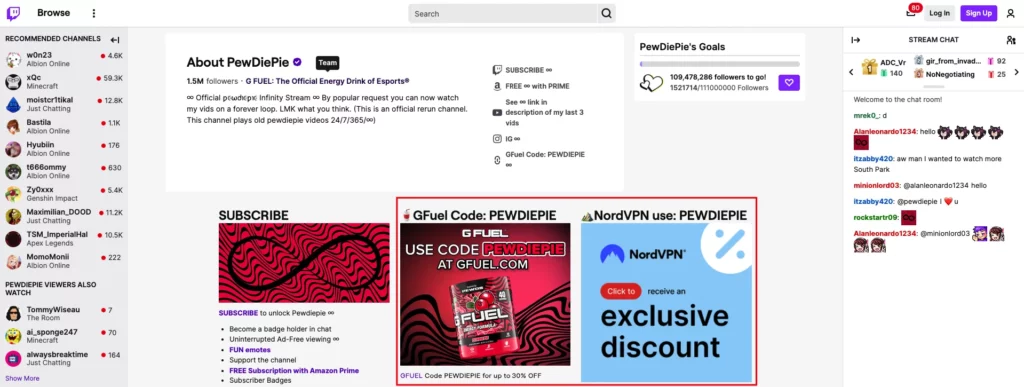
Read More: Game Streaming Setup to Be a Pro
2. Lifestyle Streamer
Lifestyle streamer is one of the streamer types that has gained much attention. Not only is it close to the daily routine, but most of the lifestyle content also brings a positive impact to their viewers.
So, if working out every day is your thing, for example, you should consider starting a live stream channel focused on fitness as a lifestyle!
For inspiration, check out how Fit For Purpose—a streamer who has already attracted 8.3K subscribers by sharing his workouts. He does stretches, push-ups, squats, and other bodyweight exercises. It’s awesome how sharing your passion can help others stay more fit, right?
Or, if you love cooking healthy food, breakfast, or cookies, you can start your cooking channel. If the audience finds your style unique, it’s possible to be a famous streamer like Jamie Oliver, who is also a cookbook author.
3. Art Streamer
Sand art is something that captivates so many people. Imagine being an art streamer with a unique niche like sand art. That would definitely make you stand out from the crowd. This type of streamer is gaining popularity in recent years, too.
There are many great sand artists out there. One of them is SandExperiment which has gathered over 22,000 followers so far on Twitch. You can take her as your inspiration or even learn from her how to make your live stream engaging.
She creates mesmerizing illustrations using sand while soothing music plays in the background. It’s truly amazing! What’s more, she is so friendly and loves to chat with her viewers while finishing her work, making the whole streaming experience even more enjoyable.
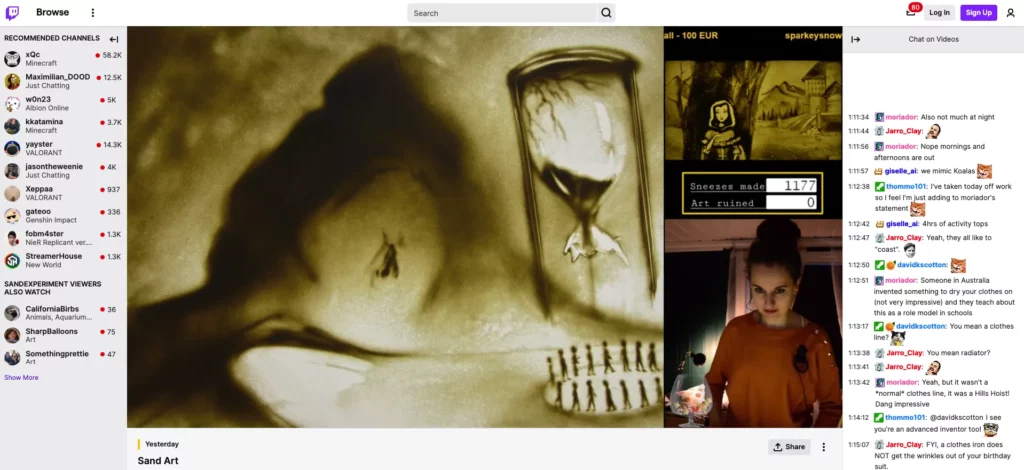
4. Music Streamer
Music streamers are one of the types of streamers that you must be familiar with. You may see them on YouTube doing a cover song from famous artists, or making their own original music using certain software.
If you feel like you can do that as well, you should try to have your own music channel. Don’t take it for granted. If you want to build a professional career as a musician, being a music streamer is one of the best options.
In fact, Sintika is a German DJ and music producer who has become the most popular music streamer with over 300,000 followers. What’s more, she is considered one of the most earning streamers, with estimated annual subscription earnings of more than $900,000.
5. Educational Streamer
Some people believe that with the advancement of technology, education is free. That’s debatable, but with so many educational streamers out there, you can surely upgrade your skills without paying a dime.
On the flip side, being an education streamer is an opportunity to attract many subscribers. You can teach people about coding, languages, or even special skill like origami.
For inspiration, Cloud English is a YouTube channel offering live streaming for their audiences or online students. Luke Priddy is known for his exceptional talent in teaching English in a fun way. He focuses more on everyday conversation and using English in specific areas like a call center, travel, and many more.
Luke doesn’t rely on YouTube as his sole platform. He also uses Instagram Live to engage with his audience. He often hosts Q&A sessions in the chat, promoting even more interaction and connection with his viewers.
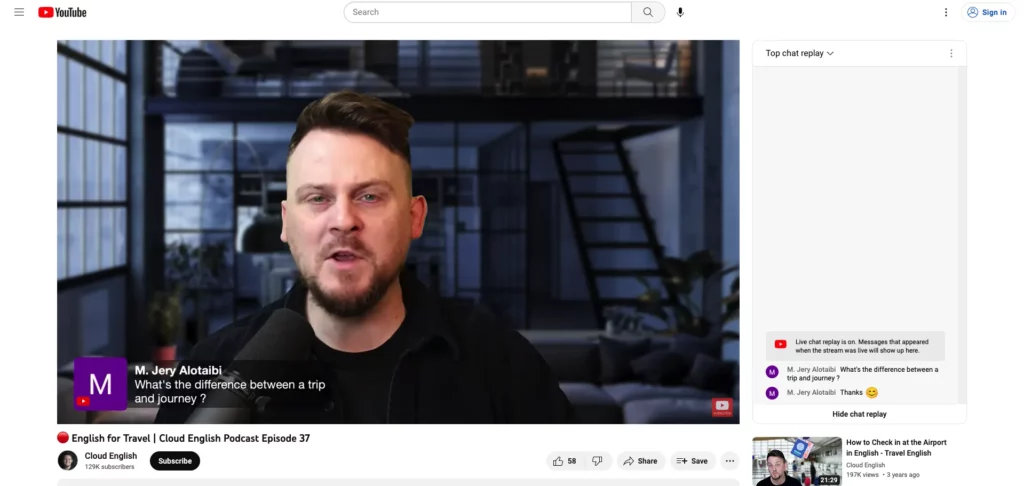
The list of streamer types can go on and on. So, if you ask, what are streamers’ niches that you need to choose? Just look at what you’re best at. That can be an idea to start your streaming channel.
Why Do People Want to be a Streamer
We’ve recognized what a streamer is and what a streamer do. But, do you know what are the reasons people want to become a streamer? There are many individual reasons for that and these are some of them:
1. Follow Their Passion
Sometimes there is no fancy reason to be a streamer. Some people do live streams because they love to do it. It allows them to communicate with others with the same interest while demonstrating what they believe is worth sharing.
This often happens to a casual streamer in a particular niche like home cooking or workout. Being a streamer, in this sense, is more as a form of expression rather than building a carrier as a professional.
For example, the late Bob Ross streams his painting technique on Twitch, which amazes millions of people with his skill.
2. Showcase Their Skills
A common reason why people become streamers is to showcase their skills to a global audience. This way, it can provide a sense of recognition for their abilities.
Let’s say you are a musician and want to receive feedback on your band’s performance of certain songs. Performing live as a music streamer can be an excellent way to do so. You can receive positive comments and constructive feedback to improve your next performance.
However, unlike those who stream primarily to follow their passion, most streamers who aim to showcase their skills have a bigger agenda. Whether as a musician or gaming streamer, they often accept donations from their viewers.
3. Earn Money as a Professional
Streamers can earn a small income by accepting donations from viewers. It’s not enough for some other who wants to turn live streaming into a profitable profession.
That’s why to achieve this, most full-time streamers focus on creating awesome content that will attract more subscribers. This way, it will lead to more earnings.
Also, it’s important to note that donations aren’t the only source of income for streamers. It’s just the start. They can also earn money through sponsorships, ads, and by selling their own products. As a result, live streaming can be a promising career choice regardless of your niche.
The Future of Streaming
The future of live streaming is promising. This is good news if you want to be a streamer online. Not only has it become popular as a form of entertainment, but a streamer is also potential for future education in which the audience can learn from the expert.

One major trend to look out for is the integration of augmented reality (AR) and virtual reality (VR) technology into live streaming. This mainly applies to a gaming streamer, but other streamers, like lifestyle streamers, can take advantage of this technology, too.
This will give viewers a more immersive experience, feeling like they are right in the middle of the action.
Another trend is the rise of mobile streaming, where viewers can tune in to their favorite streamers on the go, making it easier than ever to access and enjoy live-stream content. Isn’t it fun if you can enjoy your favorite chef doing a live-streaming and you do exactly every step that they take?
On top of that, don’t forget about the possibility of making stream platforms more versatile. Today, we have Twitch, YouTube, and Facebook Gaming, which are awesome. Imagine if there were more innovative services to come with improved features, monetization options, and better integration with social media platforms for a great engagement.
Finally, as the audience continues to grow, we can expect more mainstream adoption of the live stream. Think of media companies jumping in investment and promoting live streaming as new entertainment. It will be a huge opportunity for streamers to demonstrate their expertise.
Conclusion on What are Streamers
We hope we’ve clarified any confusion by answering the question: what is a streamer? In a nutshell, streamers are those who live-broadcast their skills, hobbies, or gameplay for various reasons. Some do it for fun, while others aim to showcase their abilities or even make a living.
Regardless of their motivation, most streamers focus on a specific niche, from gaming and art to lifestyle and education. There are numerous successful streamers in each niche that can inspire you if you’re looking to become the next big thing.
Bear in mind that being an amazing streamer isn’t just about creating awesome content. It’s also vital to engage with your audience and maintain a consistent live-stream schedule to attract more viewers.
So, what are you waiting for? Let’s dive into the world of streaming, where you can unleash your creativity and grow as a successful streamer. Also, don’t miss out on future tips from our blog for more valuable insights!
FAQs
What is a streamer?
A streamer is anyone who starts live video content and interacts with their audience on certain platform as a content creator. They may have certain niches such as gaming, lifestyle, arts, and many more. The streaming platforms often used are Twitch, YouTube, and Facebook.
What does a streamer do?
A streamer starts live streaming in front of online viewers playing video games, creating a painting, or even performing sand art in real-time. Adding to that, a streamer also needs to get in touch with their subscribers on any platforms, including social media.
Why do people stream?
The reasons why people stream vary. Some just want to share their skills, while others want to build a community of specific issues and earn money as a professional.
Where should I live-stream?
The best platform to stream on depends on your goals and the type of content you want to create. Popular options include Twitch, YouTube, and Facebook Gaming, but there are many others to choose from. Research each platform’s features, audience, and monetization options to determine which one is the best fit for you.
Is it okay to stream on multiple platforms at once?
Yes, you can do so. There are services that allow you to stream your content to multiple platforms simultaneously. However, it’s important to check the terms and conditions of each platform to ensure you are not violating any rules.
Is it possible to become a professional streamer?
Yes, you can make a streamer as your career, regardless of your niche. However, make sure you are willing to put your time into engaging with a wide audience with great content. As a streamer, your source of income can be from donations, ads, or selling your merchandise.








